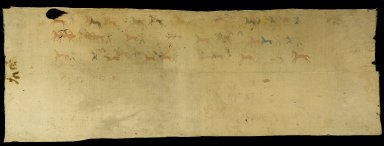
Artist:Rain-In-The-Face
Medium: Cotton, pigment, crayon, pencil
Geograhical Locations:
Dates:1850–1889
Dimensions: 201 15/16 x 67 11/16 in. (512.9 x 171.9 cm)
Collections:
Exhibitions:
Accession Number: 43.221.1
Image: 43.221.1_PS2.jpg,
Catalogue Description: Muslin tipi liner with painted and drawn images of horses and warriors. During this period, muslins did not usually function as liners, but were used as hangings that were displayed to tell personal exploits, or some were made for trade. This liner does have the marks left by the small, weight pebbles usually associated with hanging inside a tipi. It is a very large sheet composed of two long pieces joined with a seam along the center. The bottom panel is undecorated. The top section is drawn/painted and colored with ledger like drawings of horses, men in various encounters and battles. The drawings are correct, right to left. It might be individual battles from a larger fight so it might be from the big battles in which Rain-in-the-Face is known to have participated or it could depict smaller conflicts such as stealing horses and counting coup on Native and non-Native enemies. Accession notes include the information that the artist Edwin W. Deming was given the liner by Hunkpapa Lakota warrior Rain-in-the-Face during Deming's visit to Standing Rock in 1889 and Deming may have seen him painting all or part of it. Extensive notes are in curatorial files.